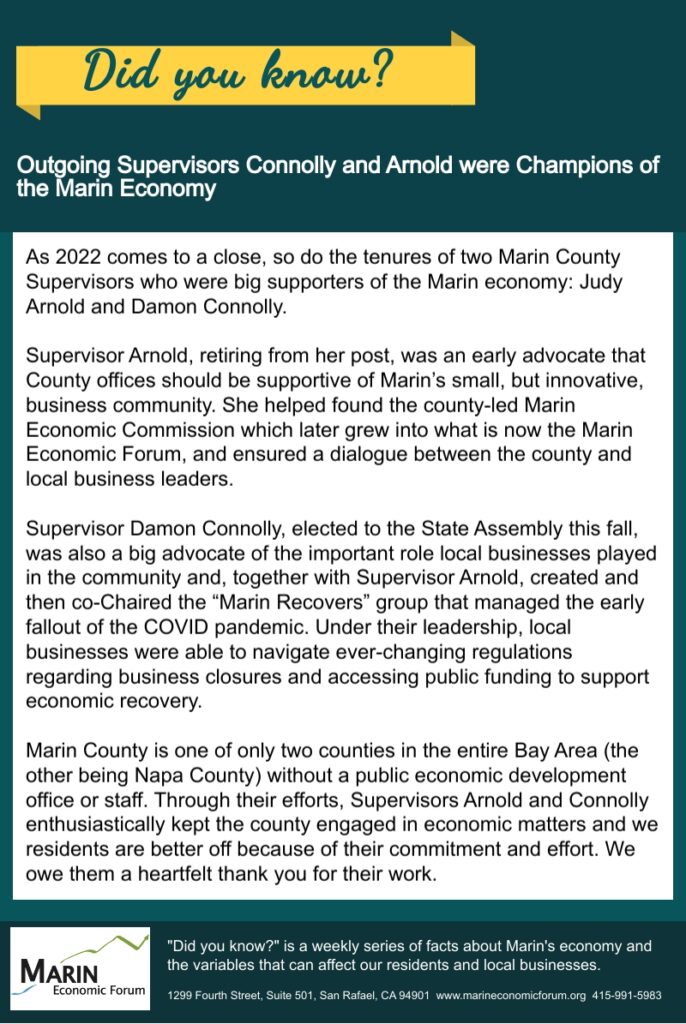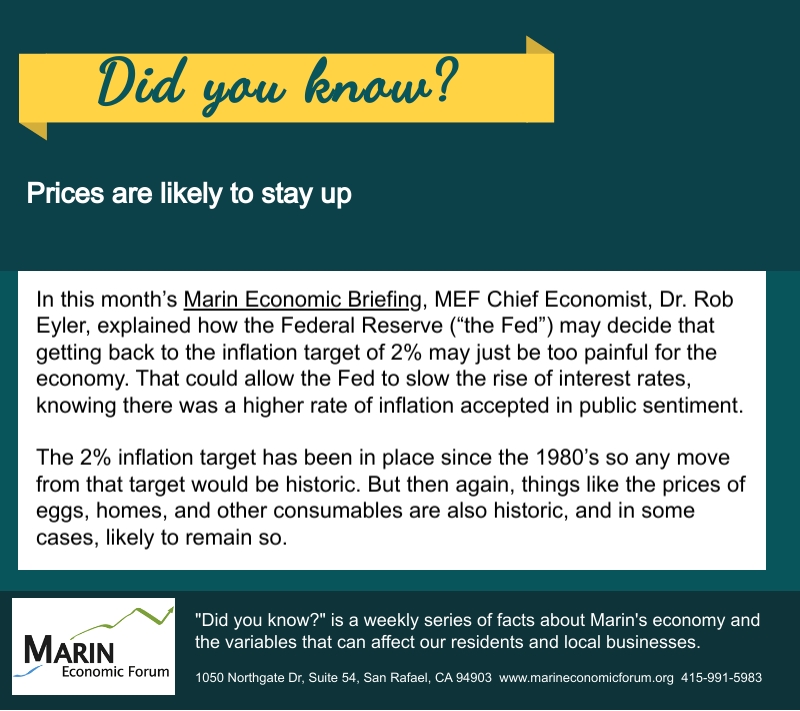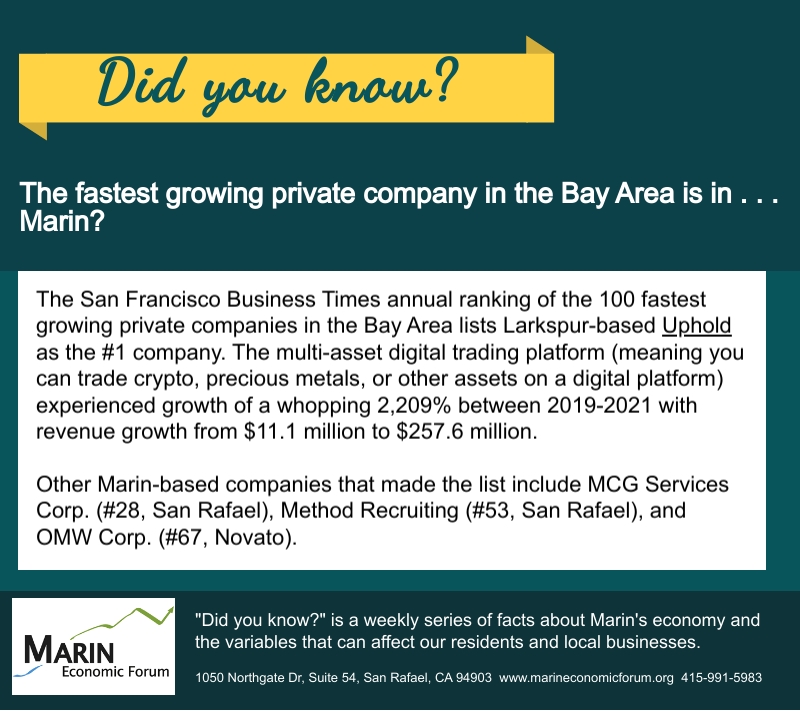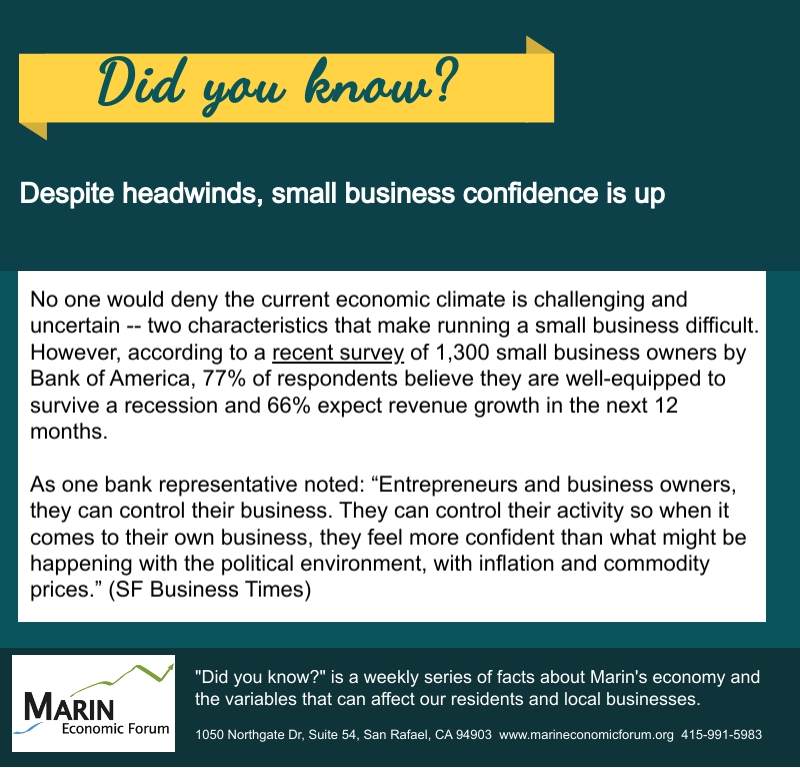January 5, 2023 Did You Know?

Be the first to receive updates and news from MEF by subscribing or liking us on our social media pages: Facebook, Twitter, and LinkedIn!

Be the first to receive updates and news from MEF by subscribing or liking us on our social media pages: Facebook, Twitter, and LinkedIn!

Be the first to receive updates and news from MEF by subscribing or liking us on our social media pages: Facebook, Twitter, and LinkedIn!
December 2022
| As 2022 ends, MEF wanted to share our observations of the year’s biggest economic news in Marin County and what to look for in 2023. Make no mistake, 2022 was a tough year economically, especially at the national level. Will we see more positive changes in 2023? At the top of the news cycle is the continuing effects of the pandemic on local businesses, concentrated in recovery of small businesses and how the local economy fares given the differences in pre and post pandemic dynamics. From MEF’s perspective, one of the most troubling issues is the reduction in the labor force by more than 5% (or about 6,000 workers). Marin already faced a challenge to hire individuals, especially in the lower-wage occupations that many businesses rely on. That problem does not seem to have a solution in the near term, considering other, lower-cost Bay Area counties where Marin could draw workers, also face similar tight labor markets. Whether it be early retirement, potential health issues arising from contracting COVID, relocation out of Marin, or the need to provide child or elder care, Marin employers faced a hiring challenge throughout the year that constrained recovery. Going into 2023, one area of optimism is that some of the workforce will return with an increase in childcare slots, driven in part with new resources from the county for childcare providers. The other related issue is inflation, which at one point reached a 40-year high, and the Federal Reserve’s attempts to manage it by raising interest rates. The resulting increase in interest rates has adversely affected one of Marin’s most important revenue stream: sales of single family homes were down 22% in November 2022 from one year ago. As the Fed continues pursuit of a 2% target for inflation, those purchases relying on financing could continue to slip, which would affect Marin retailers and public sector coffers that collect sales tax. The issue of housing continued to be a focus during 2022 as the county and jurisdictions managed the preparation of “housing elements” in response to the “Regional Housing Needs Allocation (RHNA)”, which quantified the number of new units to be built in the period of 2023-2031. Each Marin jurisdiction will need to provide a housing element in 2023, setting the stage for extensive debate across the county, ultimately to plan to build over 14,000 new units in the 8-year period. Tech layoffs in response to economic slowdowns also made headlines towards the end of the year considering many Marin residents work in that sector. It’s too early to tell what the impact will be locally, especially since highly skilled workers continue to be in strong demand more broadly, but it remains something we are watching going into 2023 where we expect the economy to slow. These issues dominated the headlines, mostly because of the impacts on residents, both positive and negative. At the MEF-level, we had several successful activities in 2022 that we believe will lead to continued economic vitality in 2023. In March of 2022, we presented “Forecasting the Future” which highlighted local entrepreneurs who were able to navigate pandemic issues and even leverage the new dynamics for business growth. Whether by launching new ecommerce capabilities, streamlining communications to parents, or helping public entities identify funding opportunities, Marin’s entrepreneurs recognized the moment and the opportunity to build companies right here. MEF continues to follow the nascent start-up ecosystem in Marin while promoting its importance to good job creation. Look for our next “Forecasting the Future” program in March 2023. MEF partnered with the County of Marin to produce the first ever economic strategy for the county. The strategy is focused on delivering growth in key economic sectors in Marin while creating more middle and high wage jobs, so our residents don’t have to look outside of the county for good employment opportunities. The strategy puts equity upfront with initiatives to improve economic mobility and support greater opportunities for entrepreneurship among Marin’s BIPOC community. In 2023, the County will be reaching out to inform and listen about the key project opportunities to implement in the strategy. Finally, MEF continued outreach and engagement of the community and the non-profit sector to ensure all stakeholders have access to our economic data and analysis. We hosted web-based “economic briefings” each month with our insights of the economy helping leaders understand the risks and opportunities for their organizations and beneficiaries. In 2023, we hope to increase our audience so spread the word! While 2022 presented significant economic challenge, the year ahead sets up to be one of resiliency among the local business community and capitalizing on new commitments to more housing and jobs in Marin County. |
Mike Blakeley, CEO
Marin Economic Forum

Be the first to receive updates and news from MEF by subscribing or liking us on our social media pages: Facebook, Twitter, and LinkedIn!

Be the first to receive updates and news from MEF by subscribing or liking us on our social media pages: Facebook, Twitter, and LinkedIn!
November 2022
| The business news headlines in recent weeks have been dominated by stories of tech layoffs, seemingly more and more every week. The numbers of job losses are not only startling but WILL have impact in the tech rich Bay Area; according to research from the Bay Area Council, each Bay Area tech job is responsible for 4 additional jobs (often in the services sector). The business media and policy makers are trying to gauge the fallout and what it might mean for local economies. It is important to understand that the layoffs are driven by business dynamics and not a single, large, exogenous event (think the subprime meltdown that created the Great Recession). The pandemic created a massive shift to digital that required tech service providers to scale rapidly. For example, Meta/Facebook grew from 58,000 to 72,000 employees between 2021-2022, which puts into perspective their recent layoff of 11,000 employees (2,564 are in the Bay Area). A correction from massive growth had been previewed earlier this year when it became obvious the economy would slow in 2023. Another key factor is timing, specifically that many publicly traded companies release their earnings reports a couple weeks after a quarter, so the layoff news that started trickling in October reflected lower-than-expected earnings for the quarter ending in September for several brand name companies. Also related to timing is the annual planning most companies go through before the next fiscal year; those companies who run Jan-Dec fiscal years submitted budgets and annual operating plans that would have enacted layoffs before the holidays. There are likely positive and negative impacts to the Marin economy. Firstly, there are limited and lagging data sources that track what sector our residents work but, anecdotally, we know a lot of our neighbors are in tech. We also know from an earlier report from the San Francisco Business Times that the new residents to Marin in 2020-2021 had higher adjusted gross incomes (AGI) than those that moved out of Marin, likely some of those being tech workers leaving the city for the suburbs. The most obvious negative impact would be a drop in consumption driven by lower discretionary income to spend on non-essential goods and services. Many Marin businesses are built to serve the more affluent consumer, with services like cosmetology and fine dining and goods, including clothing and cars. A drop in consumption among these businesses will not only impact the revenues of the businesses themselves but the funds that are generated for public entities through sales and other taxes. According to the Silicon Valley Business Journal, Bay Area tech salaries averaged $174,000 in 2022, which seems like a lot until you factor in the high cost of living across the Bay Area and Marin, where housing alone tends to gobble up well over the generally accepted ratio of 30% of income. That doesn‚Äôt leave a lot left over for a new TV, especially if that tech salary isn‚Äôt coming in. Lower consumption could set off a bit of a chain reaction among the small business sector which is just coming up for air following the pandemic. A survey of business owners by MEF in 2021 showed that business loans, credit card debt, and personal finances were increasingly keeping businesses afloat. The prospect of lower revenues or higher debt to sustain in a slow economy suggests more pain on the horizon, not only jeopardizing jobs but potentially lowering business investment and local consumption of everything from office furniture to website design. Policymakers have limited response mechanisms to business slowdowns as we saw during the pandemic, where the only response was either temporary regulatory relief or, in extreme cases, cash via grants. Neither is a likely option going forward. So where might there actually be positive effects from these layoffs? For starters, professionals in the tech sector will be demanded in other sectors, whether they be non-profits or newly emerging segments like food tech or climate tech, which happen to be popular subjects here in the nascent Marin start-up community. Further, there are already stories of laid-off employees starting new companies, and Marin is a great place for some of our resident tech experts to launch their company. The small tech community that is in Marin might potentially see some easing of their hiring challenge through a new crop of available talent – recall not all tech companies are laying off employees – mostly the large ones that grew so rapidly over the past couple years. MEF is projecting some slowdown and ‚ headwinds for the local economy going into 2023 and an uptick in unemployment among our high-income tech professionals could further exacerbate small business challenges. However, local leaders can seek the silver lining by continuing to find ways to support the local entrepreneurship ecosystem, especially for new generation start-ups, or by supporting the types of networking and conferences that connect professionals and create linkages to employment. |
Mike Blakeley, CEO
Marin Economic Forum

Be the first to receive updates and news from MEF by subscribing or liking us on our social media pages: Facebook, Twitter, and LinkedIn!

Be the first to receive updates and news from MEF by subscribing or liking us on our social media pages: Facebook, Twitter, and LinkedIn!

Be the first to receive updates and news from MEF by subscribing or liking us on our social media pages: Facebook, Twitter, and LinkedIn!

Be the first to receive updates and news from MEF by subscribing or liking us on our social media pages: Facebook, Twitter, and LinkedIn!